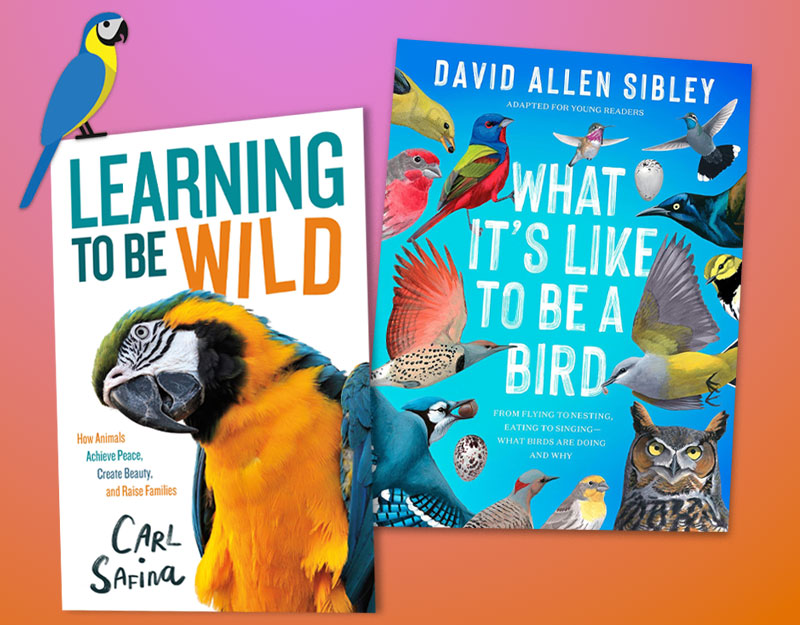2 Books About the Robust Lives of Animals | Nonfiction Middle to High School Spotlight
These two titles, both young reader adaptations of adult nonfiction books, put readers in the shoes (or, more accurately, the feathers and families) of their animal counterparts.

These two titles, both young reader adaptations of adult nonfiction books, put readers in the shoes (or, more accurately, the feathers and families) of their animal counterparts. Safina discusses the role of culture among animals in Learning to Be Wild, while Sibley explores all things avian in What It’s Like to Be a Bird.
Safina, Carl. Learning to Be Wild (A Young Reader’s Adaptation): How Animals Achieve Peace, Create Beauty, and Raise Families. 224p. Roaring Brook. Aug. 2023. Tr $19.99. ISBN 9781250838254.
Gr 6 Up–Some things are inherited from generation to generation, like genes. Other things are learned by culture. Every group has a culture, be it humans, chimpanzees, macaws, or sperm whales. Adapted from ecologist Safina’s Becoming Wild, this book is divided into the same three parts, but presented in a different order: Achieving Peace, Creating Beauty, and Raising Families. The short, direct sentences intersperse Safina’s travels with research, which allows for smooth, easy-to-follow reading. The case for protecting animals—and their cultures—is strong throughout the text, as Safina demonstrates what is lost when culture is threatened or disappears altogether. Animal-loving readers will enjoy the storytelling and photographs that bring further life to the people and creatures introduced in the book. However, there are some missed opportunities to make the text more relatable to a younger audience. Analogies such as “a pressure cooker waiting to explode” or lamenting a time before the information age, something digital natives might not grasp, may alienate some of the intended audience. The lack of back matter or suggested reading might make it a difficult sell as a research aide for students. VERDICT Scientists-in-the-making will enjoy this glimpse into future possibilities.–Elissa Cooper
 Sibley, David Allen. What It’s Like to Be a Bird (Adapted for Young Readers): From Flying to Nesting, Eating to Singing—What Birds Are Doing and Why. 208p. Delacorte. Oct. 2023. Tr $19.99. ISBN 9780593430187.
Sibley, David Allen. What It’s Like to Be a Bird (Adapted for Young Readers): From Flying to Nesting, Eating to Singing—What Birds Are Doing and Why. 208p. Delacorte. Oct. 2023. Tr $19.99. ISBN 9780593430187.
Gr 4-8–From well-respected birding expert Sibley comes this beautifully illustrated book for middle grade readers, delving into such questions as, “Why do birds need feathers?” and “How do birds find food?” The writing is fairly detailed, yet each bird introduced is limited to a spread complete with a colored illustration, making it easier to digest the details. Sensibly organized, Sibley focuses on the essence of each bird species presented. With crows he may focus on behavior, yet with a finch he may choose to share information on feeding or nest building. For readers who may only glean tidbits, there are some mesmerizing facts. Did you know that feathers wear out, birds have no teeth, and all birds molt? In addition to excellent information about a variety of birds, there are occasional activities peppered throughout. There are bird species presented from across the entire United States. Whether readers live in an urban or rural area, we all have birds in our communities to observe and learn about. Sibley achieves this by sharing his own dedication to and fascination with our feathered friends, truly answering the titular question, “What it’s like to be a bird?” VERDICT A superior volume of well-researched facts and figures; a must-have for young bird nerds.–Linda Annable
RELATED
Tide’s Journey
Whose Footprint Is That?
The Tiniest Giant
The job outlook in 2030: Librarians will be in demand
The job outlook in 2030: Librarians will be in demand
ALREADY A SUBSCRIBER? LOG IN
We are currently offering this content for free. Sign up now to activate your personal profile, where you can save articles for future viewing






Add Comment :-
Be the first reader to comment.
Comment Policy:
Comment should not be empty !!!